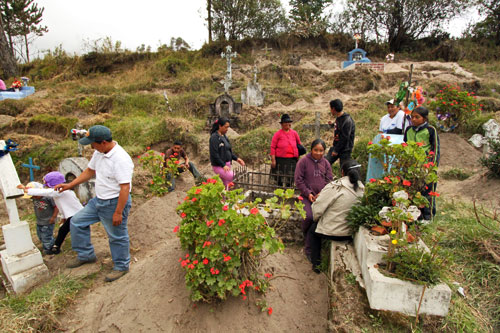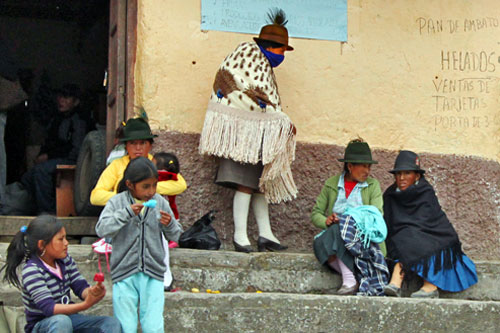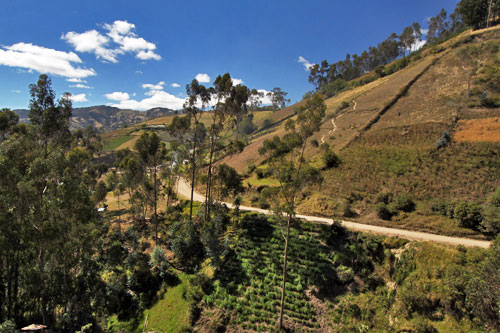I thought I was so clever. Ecuador’s President Correa had combined three national holidays into one to create the longest holiday weekend in the history of the country on November 2-6, so instead of winging it as usual, I’d made reservations in Chugchilan, a tiny town in the central mountains renowned for its volcanoes, stunning scenery, and hiking. Unfortunately, I hadn’t given any thought to how I would get to Chugchilan on the day when half a million people flee Quito for their hometowns to honor their ancestors on Dia de los Difuntos, the Day of the Deceased.

A taxi driver burst my confidence bubble the night before I was scheduled to leave Quito. “No es posible para viajar a Chugchilan manana por la manana porque todos los buses estara llena,” he warned. It is not possible to travel to Chugchilan tomorrow because all the buses will be completely full.
The owner of my hostel said my best bet would be to arrive at the terminal as early as possible and hope for the best, so at the crack of dawn the next morning I walked up the ramp to the ticket booths at Quitumbes Terminal and into a sea of humanity. I fought my way up to the only window that was selling tickets for Latacunga, the town where I would need to change buses for Chugchilan, and suddenly realized that the seething crowd was actually dozens of lines formed up in front of the ticket windows. Following the queue backwards I asked every few feet, “Esta es la linea para Latacunga?” Is this the line for Latacunga? “Si, Senora,”was the repeated reply, more often than not accompanied by rolling eyes or shrugged shoulders. On the opposite side of the terminal I finally reached the end of line and took my place, harboring little hope that I would be able to reach my destination. Although there was a bus leaving for Latacunga every 45 minutes, I had to arrive no later than 11:30 a.m. to transfer to one of only two buses that goes to Chugchilan each day.
Just as I was about to give up and go back to my hostel in Quito a man walked by shouting, “Taxi a Latacunga!” “Cuanto?” I asked. How much? “Cuarenta dolares,” he replied. Forty dollars. I grimaced and shook my head. “Pero con cuatro es solo diez dolares cada uno.” But with four people it is only $10 each. With that, he and his compañero were off to find three other passengers, even though I had not agreed to his offer. My mind raced. What to do? My experience so far had been that independent travel in Ecuador is generally safe, but was accepting a ride with a stranger safe? The men were obviously not driving a legal taxi. For all I knew, they were thieves and I could end up in the mountains with my throat slit. Before I could ask the woman in front of me for her opinion they were back with an Ecuadorian family of three in tow – mother, father and teenage daughter. Hesitantly, I asked the father if he thought this was safe and he assured me it would be fine. Seeing my indecision he explained that the men were going to Latacunga to visit their families and were offering to take other passengers to make a little extra money. It was split-second decision time. My gut told me the situation was legitimate. I followed them out the exit.
Two and a half hours later they dropped me at the bus terminal in Latacunga with wishes for a good trip. Once again, my trusty gut had served me well. I bought a $2.50 ticket for the early bus to Chugchilan Ecuador and asked the driver to open the lower storage bay but he shook his head and motioned for me to carry my luggage into the bus. Hefting my backpack and suitcase up the steep steel steps, I struggled down the narrow walkway to my aisle seat near the back of the bus, where the stench of gasoline permeated the air. I stuffed my backpack on the floor behind my feet and my suitcase in the aisle next to me, concerned that other passengers would not be able to get by. I needn’t have worried. As the bus filled up my suitcase was quickly buried beneath satchels, giant plastic shopping bags, and sacks of potatoes and onions. A Quichua woman appeared at my side and directed her son to climb over me into the window seat. My delight that his small size would give me more room to move around turned to dismay when the woman also started to climb over me and I realized that the three-hour trip would be done with three people crammed into a seat designed for two.

As the bus rumbled out of the station, extended family members began passing around containers of hot food. My seat-mate spoon fed the boy and then cradled him in her arms, poking me in the breast with her jutting elbow. With legs pretzeled and head hanging over his mother’s arm the boy slept, but he grew restless as the odor of gasoline grew stronger. Suddenly, he sat up halfway and threw up repeatedly into a plastic bag his mother had at the ready. He fell back into a comatose sleep, leaving his mother to juggle a sack of food and a bag of vomit while still cradling her son. I couldn’t stand it anymore. Though I didn’t know the Spanish word for “lap,” I offered to let her son lie across both of us. Between two women, no words were necessary; I could have motioned for him to lie down and she would have understood. With a shy but grateful smile, she gently lowered him onto my lap, where I balled my sweatshirt up into a pillow to cushion his head.
And so we rode. A single baby shoe, hanging from a roof vent by a dirty shoelace, bounced in time as the raggedy bus clattered over a road more rock than dirt. Young girls clambered over piles of luggage with offerings of biscuits to placate wailing babies. A twenty-something woman in tight jeans and high-heeled boots sauntered saucily up the aisle to greet male friends with air kisses on cheeks.

The serpentine road enfolded upon itself, climbing ever higher into ice-cream scooped hills. Outside the scene was a patchwork of neatly planted gold and green fields. Inside I looked down upon the cafe au lait skin and thick black lashes of a precious young boy sleeping contentedly in my lap. When we finally ground to a halt in Chugchilan the mother wordlessly roused her son, stepped over me and was gone without a word. No thanks were offered; none were expected. It was nothing more or less than any Ecuadorian would have done.

Hey great article – but you can also “travel like a local” by riding a motorcycle which is one of the most popular forms of transport in Ecuador. You can rent bikes from Ecuador Freedom Bike Rental in Quito with a GPS that will take you on the best of the Quilotoa Loop and even let you start and stop when you want – that is what an outdoor adventure is all about!
Lovely Place for holidays
I lived in Ecuador for nearly a year. For the most part, a taxi, or any sort of transport between towns, is a guy with a truck. Loved it, and it got me most anywhere I wanted to go.
Awesome!!!
Love it! I swear I have a similar experience with a vomit filled bus but in Morocco! I love all of the women’s hats that they wear. Is that throughout the country or just outside of the cities?
Hi Ottsworld: The Quichua (Ecuador) and Quechua (Peru) all wear them. Both are descendants of the Inca, who inhabited the Sierras and the coastal plains, and though many do live in the cities, the indigenous populations are most prevalent these days in the mountains, so that’s the place where the traditional bowler hats are most often seen.
We shall not cease from exploration and the end of all our exploring will be to arrive where we started and know the place for the first time.
This sharing information look of wonder! More benefit for every peoples. I love this all information.
Really the travel location looked down upon the news are good! This news i have follow that every tour place!
What a great series of posts. You’re writing is incredible, it feels just as if I’m travelling alongside you. I’m curious as to what was in the boys bag!?
Hi Will: Don’t recall that the boy had a bag but the mother was juggling a bag of food and another of vomit!
I felt like I was there in the seat beside you. I could relate to a similar experience on a packed mini bus in Zambia where I ended up cradling someone’s daughter for half the trip. Beautifully written and lovely scenery by the look of things.
Wow that sounds like a real adventure!
I’ve often found travelling like a local is a lot more rewarding even if certain comforts are discarded. I think as some others have mentioned, trusting your instincts is something I often follow and it’s never led me astray.
What a lovely post, Barbara. Often the most trying experiences (very often transport) end up being the most memorable.
I think you’re very brave traveling alone, however you must have lots of self confidence and a way with people. Kindness is always appreciated, Like your kindness to the little boy and his mother.
Hi Lyn: I hear that all the time, but traveling alone just becomes normal after a while. It doesn’t take any special bravery and the more I travel, the more I realize that people the world over are more alike than different. I do love connecting with different people and becoming a part of their lives, if only for a little while.
In some countries I’ve been to, I try to learn some of their common expression and use it when dealing at their markets to avoid being charged as a tourist. It helps me save more. 🙂
Hello Bali Villa – good tip! Much appreciated.
What a beautifully written post! One thing I am learning in my travels is to trust my instinct a little more. Sometimes it tells me ‘no’ and that’s hard to listen to on a trip. However, you made the right decision on this trip.
Honestly, I am not sure that I would have made the same decision as you with a little boy. But what a beautiful picture of compassion and humanity!
Thank you Jeremy. I always try to tune into my gut and trust it. So far, so good!
I think this story encapsulates all that is good and bad about solo travel – “the great uncertainty” that frustrates at times but usually works out really well.
Hi Mark: I must admit that I have had my share of challenges in South America, but it’s moments like these that make it worth the struggle.
very well written. That’s the way to go native!
lovely post
Beautiful.
Wow what an experience!!! Great pics!